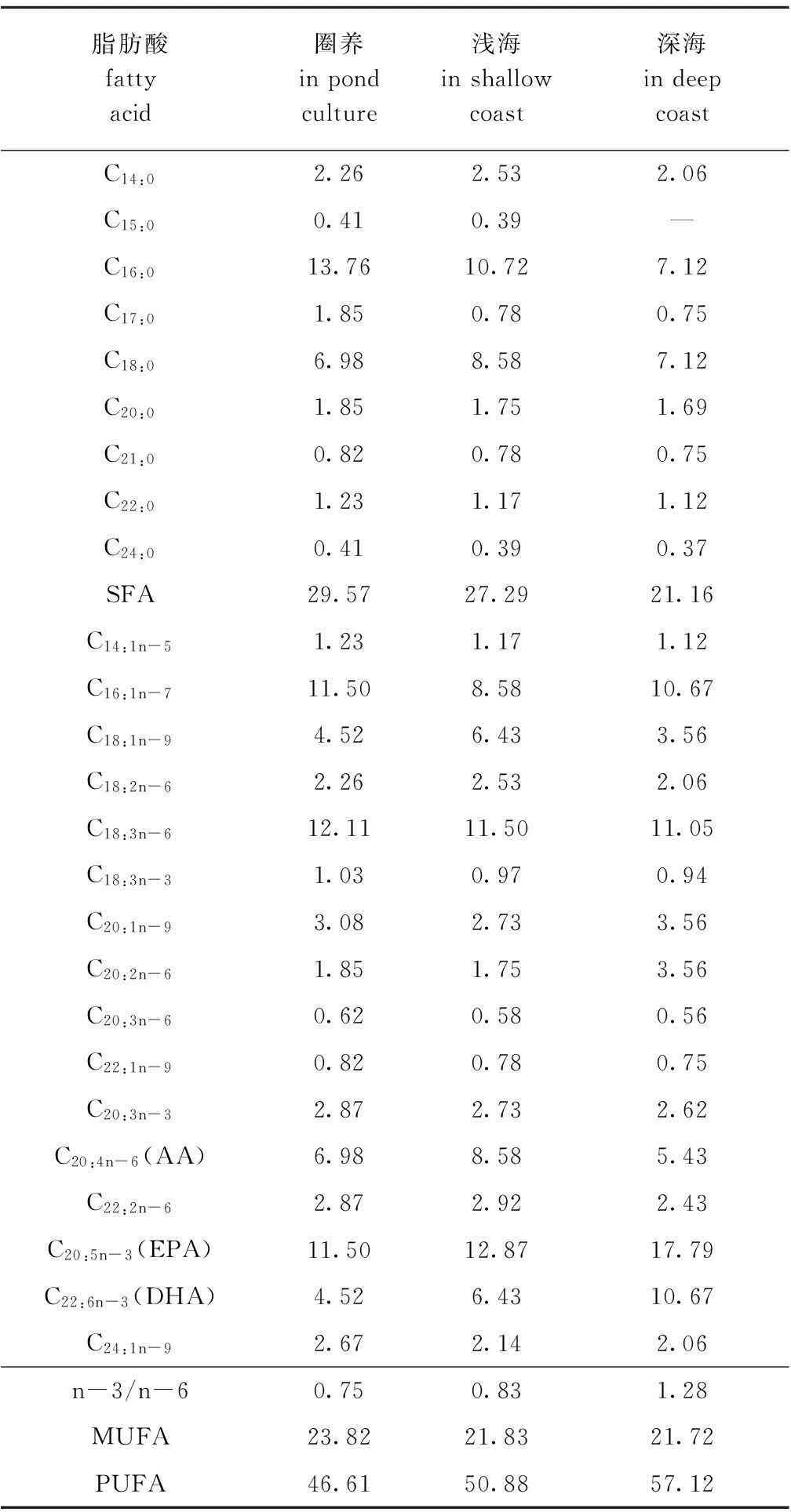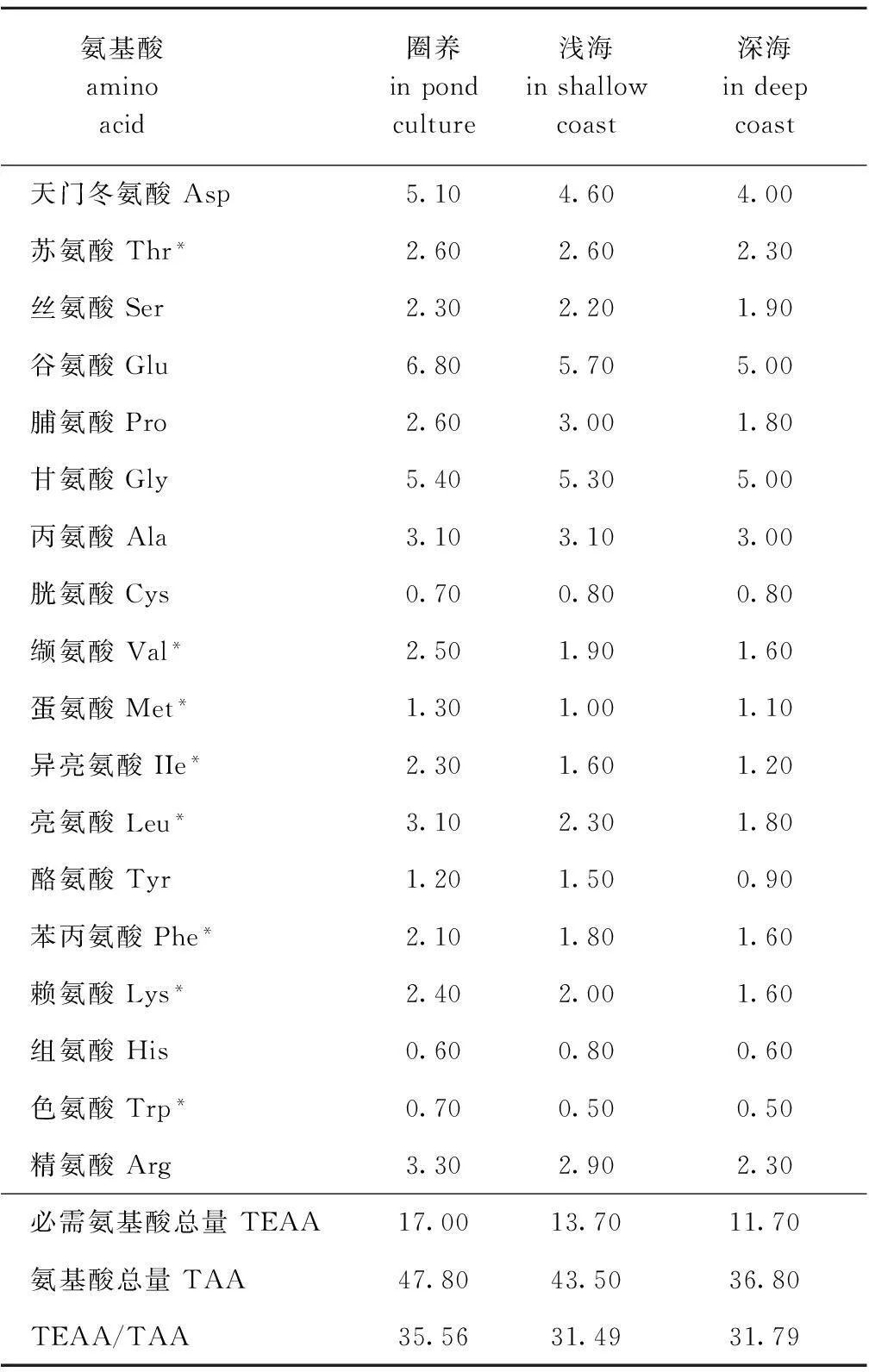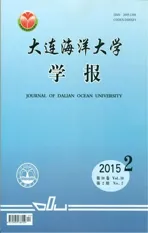3种养殖方式下刺参营养成分和功能成分的研究
2016-01-26王贵滨郭振宇高岳林研彤李智博
王贵滨,郭振宇,高岳,林研彤,李智博,
祁艳霞1,胡玉才3,赵前程1
(1.大连海洋大学 食品科学与工程学院,辽宁 大连 116023;2.辽宁出入境检验检疫局,辽宁 大连 116001;3.大连海洋大学 理学院,辽宁 大连 116023)
3种养殖方式下刺参营养成分和功能成分的研究
王贵滨1、2,郭振宇1,高岳1,林研彤1,李智博1,
祁艳霞1,胡玉才3,赵前程1
(1.大连海洋大学 食品科学与工程学院,辽宁 大连 116023;2.辽宁出入境检验检疫局,辽宁 大连 116001;3.大连海洋大学 理学院,辽宁 大连 116023)
摘要:对大连地区圈养、浅海和深海3种养殖方式下平均体质量分别为67.11、96.15、258.40 g刺参Apostichopus japonicus的营养成分(灰分、蛋白质、脂肪、碳水化合物、氨基酸、脂肪酸)、功能成分(多糖、胶原蛋白)进行比较分析。结果表明:圈养刺参的蛋白质、脂肪和碳水化合物含量最高,灰分含量最低;圈养刺参的多糖含量最高,且含有较高的氨基糖和糖醛酸,而深海刺参的胶原蛋白含量最高;3种养殖方式下,刺参的脂肪酸含量均以多不饱和脂肪酸为主,其中,深海刺参所含的多不饱和脂肪酸最高,尤其是EPA;3种养殖方式下,刺参的谷氨酸含量均最多,圈养刺参的必需氨基酸含量最高。研究表明,不同养殖方式下,刺参的营养成分和功能成分有明显差异,本研究结果可为生产者加工和消费者购买刺参提供参考。
关键词:刺参;营养成分;氨基酸;脂肪酸;养殖方式
刺参Apostichopusjaponicus隶属于棘皮动物门Echinodermata、海参纲Holothuroidea、楯手目Aspidochirota、刺参科Stichopodidae、仿刺参属Apostichopus,名列海产“八珍”之首。刺参含有丰富的营养物质,不仅具有蛋白质含量高、脂肪含量少的特点,同时含有丰富的氨基酸、脂肪酸、矿物元素[1-3],以及多糖、皂苷和胶原蛋白等多种活性物质,并具有抗肿瘤活性、抗凝血活性、抗血栓活性、抗血脂活性、抗氧化活性和增强免疫活性[4]等多种生理功能。
中国刺参产业是一个重要的渔业产业。近几年,刺参以其特有的营养价值和药用价值得到了消费者的广泛青睐。大连刺参为中国海参产业三个主产区之一,深受广大消费者的喜爱。消费者一般认为,野生刺参的营养价值高于圈养刺参,生产者及销售商也经常以此为定价的依据,而野生刺参与圈养刺参的营养成分实际上也存在着差异,其实还存在着不少争议。李丹彤等[5]研究了不同季节野生仿刺参Apostichopusjaponicus的营养成分,但是关于养殖方式对刺参营养成分影响的研究还鲜见报道。为此,本研究中对不同养殖方式下刺参的营养成分和功能成分进行了分析,既能为消费者在购买刺参时提供指导,也能为生产者加工和销售者营销刺参时提供参考。
1材料与方法
1.1材料
圈养刺参取自大连市庄河某养殖场,浅海刺参取自大连市旅顺黄泥川水深15 m的海域,深海刺参取自大连市旅顺黄泥川水深36 m的海域。圈养刺参、浅海刺参、深海刺参的平均体质量分别为67.11、96.15、258.40 g,每种养殖方式刺参的样品总质量均为15 kg。3种刺参于2012年6月采集后置于加冰的泡沫箱中运回实验室。
1.2方法
1.2.1样品的制备将刺参去内脏清洗后,于-25 ℃下平板速冻5 h,再放入冰柜(-18 ℃)中保存。将冷冻刺参切片后用真空干燥机冷冻干燥h,利用高速离心粉碎机将刺参粉碎,过80目筛,置于聚乙烯袋中,封口,于-18 ℃下保存备用。检测前,使用烘箱在105 ℃下干燥至恒重。
1.2.2基本营养成分的测定根据食品中蛋白质(ISO-5983 118—2005,换算系数为6.25)、灰分(ISO 5984—2002)、脂肪(ISO 6492—1999)含量的测定方法分别测定样品的蛋白质、灰分、脂肪含量;根据Vieira等[6]的方法测定碳水化合物含量,利用苯酚-硫酸法[7]测定总糖含量。
1.2.3胶原蛋白含量的测定依据肉与肉制品中羟脯氨酸含量测定方法(ISO 3496—1994)测定羟脯氨酸含量(换算系数为11.1)。
1.2.4氨基酸、脂肪酸组成的测定依据动物饲料中氨基酸(ISO 13903—2005)、脂肪酸(ISO/TS 17764-2—2002)含量的测定方法分别测定氨基酸、脂肪酸的组成及含量。
1.2.5多糖及单糖含量的测定采用3,5-二硝基水杨酸比色法[8]测定还原糖含量,总糖含量减去还原糖含量即为多糖含量。采用半胱氨酸硫酸法[9]测定岩藻糖硫酸酯含量,采用盐酸水解-BaCl2重量法[10]测定硫酸根含量,采用咔唑比色法[11]测定糖醛酸含量,采用Elson-Morgan法[12]测定氨基糖含量。
1.3数据处理
试验数据用平均值±标准差表示,试验指标的检测均进行3次重复测定。采用SPSS 17.0软件进行单因素方差分析,利用Tukey HSD法进行组间比较,显著性水平设为0.05。
2结果与讨论
2.1不同养殖方式下刺参的基本营养成分
从表1可见:3种养殖方式下,刺参的灰分含量为23.94%~27.96%,不同养殖方式组间存在显著性差异(P<0.05),圈养刺参的灰分含量最低,深海刺参的灰分含量最高;蛋白质含量为50.32%~53.04%,圈养刺参显著高于深海刺参(P<0.05);脂肪含量为1.65%~2.32%,圈养刺参显著高于浅海和深海刺参(P<0.05);碳水化合物含量为16.25%~18.79%,不同养殖方式组间存在显著性差异(P<0.05),圈养刺参含量最高,深海刺参含量最低。该结果与李丹彤等[13]对野生刺参基本营养成分的测定结果相近,蛋白质含量略低于王永辉等[14]的测定结果,但灰分含量偏高。
2.2不同养殖方式下刺参的胶原蛋白含量
从表1还可见,圈养和浅海刺参胶原蛋白含量无显著性差异(P>0.05),但均显著低于深海刺参(P<0.05)。这一结果低于大红海参Parastichopuscalifornicus[15]、红刺参Stichopusjaponicus[16]和马来西亚白尼参Bohadschiaspp.[17]的胶原蛋白含量,这可能与海参品种不同有关。
表1不同养殖方式下刺参的基本营养成分及胶原蛋白含量(干质量)
Tab.1Proximate composition and collagen content in sea cucumber farmed in different patterns(dry weight)

w/%
注:同列中标有不同小写字母者表示组间有显著性差异(P<0.05),标有相同小写字母者表示组间无显著性差异(P>0.05),下同
Note:The means with different letters within the same column are significant differences at the 0.05 probability level, and the means with the same letters within the same column are not significant differences, et sequentia
2.3不同养殖方式下刺参的脂肪酸组成及含量
对3种养殖方式下刺参的脂肪酸测定结果如表2所示,3组刺参均含有25种脂肪酸,包含9种饱和脂肪酸和16种不饱和脂肪酸。其中,不饱和脂肪酸的含量明显高于饱和脂肪酸,并且不饱和脂肪酸中多不饱和脂肪酸远高于单不饱和脂肪酸。
3组刺参中,圈养刺参饱和脂肪酸含量最高,为29.57%,深海刺参含量最低,为21.16%,深海刺参含量与红刺参(22.15%)、绿刺参Apostichopusjaponicus的含量(21.99%)[18]相近,低于獐子岛仿刺参的含量[5]。其中,棕榈酸(C16:0)、硬脂酸(C18:0)是3组刺参的主要饱和脂肪酸,且含量分别为7.12%~13.76%、6.98%~8.58%,高于土耳其海参Holothuriatubulosa的含量[3],低于葡萄牙海参Holothuriaforskali的含量[19]。
表2不同养殖方式下刺参脂肪酸的组成及含量
Tab.2Fatty acid compositions and contents in sea cucumber farmed in different patterns

%
注:—示未检出;SFA为饱和脂肪酸;MUFA为单不饱和脂肪酸;PUFA为多不饱和脂肪酸
Note:—, not detected; SFA, saturated fatty acids; MUFA, monounsaturated fatty acids; PUFA, polyunsaturated fatty acids
3组刺参中,圈养刺参单不饱和脂肪酸含量最高,为23.82%,远低于獐子岛刺参(38.6%)[5],与红刺参、绿刺参的含量[18]相近;棕榈油酸(C16:1n-7)是单不饱和脂肪酸中含量最高的脂肪酸,圈养、浅海和深海养殖刺参中的含量分别为11.5%、8.58%和10.67%。
本研究中,深海刺参的多不饱和脂肪酸含量最高,且EPA含量高达17.79%,Ginger等[20]研究也表明,深海区域海参的多不饱和脂肪酸含量较高,可能与深海高压、低温环境有关。另外,3组刺参的γ-亚麻酸(C18:3n-6)含量都很高且组间差异不明显。EPA是主要的n-3多不饱和脂肪酸,3组刺参的EPA含量为11.50%~17.79%,DHA次之,含量为4.52%~10.67%,其中,深海刺参DHA含量明显高于圈养和浅海养殖的刺参。
2.4不同养殖方式刺参的氨基酸组成及含量
3组刺参中均检测出18种氨基酸(表3),包含8种必需氨基酸,氨基酸总量分别为47.80%、43.50%、36.80%,其中,圈养和浅海刺参的氨基酸总量相近,均明显高于深海刺参。该结果高于红刺参、绿刺参[18]和大红海参[2]的氨基酸含量。
表3不同养殖方式下刺参氨基酸的组成及含量
Tab.3Amino acid compositions and contents in sea cucumber farmed in different patterns

%
注:*为必需氨基酸
Note: *essential amino acids
3组刺参的必需氨基酸总量为11.70%~17.00%,其中圈养刺参含量最高,深海刺参含量最低,这可能是由于不同养殖方式下海参的饵料不同造成的[21]。这一结果高于红刺参、绿刺参的必需氨基酸含量[18]。必需氨基酸中,圈养刺参的亮氨酸含量最高,苏氨酸、缬氨酸次之,而浅海和深海刺参中苏氨酸含量最高。
3组刺参中各氨基酸组分的含量差异不大,其中,谷氨酸含量均为最高,占氨基酸总量的13.1%~14.2%。大红海参[2]、北大西洋海参Cucumariafrondosa[22]中均是谷氨酸含量最高,而葡萄牙海参[19]中丙氨酸含量也为最高。本试验中,甘氨酸在3组刺参中含量也较高,这个结果低于Wen等[1]测得的5种海参Stichopusherrmanni、Thelenotaanax、Holothuriafuscogilva、Holothuriafuscopunctata、Actinopygacaerulea的甘氨酸含量,高于红刺参、绿刺参的甘氨酸含量[18]。
圈养刺参的必需氨基酸含量/氨基酸总量值最高,为35.56%,接近FAO/WHO推荐的蛋白质营养评价的理想模式[23]。说明大连圈养刺参必需氨基酸的营养价值比较高,易于人体吸收。
2.5不同养殖方式下刺参的多糖含量分析
从表4可见:3组刺参的多糖含量为7.94%~9.50%,浅海刺参多糖含量与深海刺参相近,均低于圈养刺参,但浅海刺参显著低于圈养刺参(P<0.05);3组刺参中,浅海刺参的氨基糖和糖醛酸含量与深海刺参无显著性差异(P>0.05),而圈养刺参氨基糖和糖醛酸含量最高,分别为0.31%~0.43%、7.76%~9.63%,此结果与Liu等[24]测得的刺参糖醛酸含量相近;3组刺参的岩藻糖含量无显著性差异(P>0.05),变化范围为3.76%~4.51%,此结果与Yu等[25]测得的海地瓜Acaudinamolpadioides的岩藻糖含量相近;3组刺参的硫酸根含量相差不大(P>0.05),变化范围为3.08%~3.38%。
表4不同养殖方式下刺参多糖及其单糖的组成及含量
Tab.4Monosaccharide and polysaccharide compositions and contents in the sea cucumber farmed in different patterns

%
3结论
3种养殖方式下,刺参均含有较高含量的蛋白质和较低含量的脂肪,同时,也含有较丰富的胶原蛋白和多糖等生物活性物质。圈养刺参蛋白质、脂肪、碳水化合物和多糖含量最高,深海刺参灰分和胶原蛋白含量最高;圈养刺参单不饱和脂肪酸及总脂肪酸含量最高,深海刺参多不饱和脂肪酸含量最高,而且深海刺参的EPA和DHA含量显著高于浅海和圈养刺参;圈养刺参必需氨基酸和氨基酸总含量最高;3种养殖方式下,刺参的多糖及其单糖组成有显著性差异。
参考文献:
[1]Wen J,Chaoqun H.Chemical composition and nutritional quality of sea cucumbers[J].Published Online in Wiley Online Library,2010,17:2469-2473.
[2]Bechtell P J,Oliveira A C M,Demir N.Chemical composition of the giant red sea cucumber,Parastichopuscalifornicus,commercially harvested in Alaska[J].Food Science & Nutrition,2013, 1(1):63-73.
[3]Aydin M,Sevgili H,Yilmaz E,et al.Proximate composition and fatty acid profile of three different fresh and dried commercial sea cucumbers from Turkey[J].International Journal of Food Science and Technology,2011,46:500-508.
[4]王斌,袁甜,张译文,等.仿刺参肠多糖提取物对小鼠实体瘤的抑制作用[J].大连海洋大学学报,2012,27(3):195-199.
[5]李丹彤,常亚青,吴振海,等.獐子岛夏秋季野生仿刺参体壁营养成分的分析[J].水产科学,2009,28(7):365-369.
[6]Vieira R P,Mourão P A.Occurrence of a unique fucose-branched chondroitin sulfate in the body wall of a sea cucumber[J].Biological Chemistry,1988,263(34):18176-18183.
[7]Dubois M,Gilles K A,Hamiltion J K,et al.Colorimetric method for determination of sugars and related substances[J].Analytical Chemistry,1956,28:350-356.
[8]赵凯,许鹏举,谷广烨.3,5-二硝基水杨酸比色法测定还原糖含量的研究[J].食品科学,2008,28(8):534-536.
[9]Dische Z A,Shettles L B.A specific color reaction of methylpentose and a spectrophotometric micromethod for their determination[J].Biological Chemistry,1948,175(2):595-603.
[10]Dodgson K S,Price R G.A note on the determination of the ester sulphate content of sulphated polysaccharides[J].Biochemistry,1962,84(1):106-110.
[11]Bitter T,Muir H M.A modified uronic acid carbazole reaction[J].Analytical Biochemistry,1962,4:330-334.
[12]Ressing J L,Strominger L J,Leloir F L.A modified calorietric method for the estimation of N-acetylamino sugars[J].Biological Chemistry,1955,217(2):959-1006.
[13]李丹彤,常亚青,陈炜,等.獐子岛野生刺参体壁营养成分的分析[J].大连水产学院学报,2006,21(3):279-282.
[14]王永辉,李培冰,李天,等.刺参营养成分分析[J].氨基酸和生物资源,2010,32(4):181-182.
[15]Liu Z,Oliveira A C M,Su Y C.Purification and characterization of pepsin-solubilized collagen from skin and connective tissue of giant red sea cucumber(Parastichopuscalifornicus)[J].Journal of Agricultural and Food Chemistry,2009,58(2):1270-1274.
[16]Park S Y,Lim H K,Lee S,et al.Pepsin-solubilised collagen(PSC) from red sea cucumber (Stichopusjaponicus) regulates cell cycle and the fibronectin synthesis in HaCaT cell migration[J].Food Chemistry,2012,132:487-492.
[17]Siddiqui Y D,Arief E M,Yusoff A,et al.Isolation of pepsin-solubilized collagen(PSC) from crude collagen extracted from body wall of sea cucumber(Bohadschiaspp.)[J].International Journal of Pharmacy and Pharmaceutical Sciences,2013,5(2):555-559.
[18]Jiang K H,Dong S L,Gao Q F,et al.Comparative study on nutrient composition and growth of green and red cucumberApostichopusjaponicus(Selenka,1867),under the same culture conditions[J].Aquaculture Research,2013,44:317-320.
[19]Pereira D M,Valentao P,Teixeira N,et al.Amino acids,fatty acids and sterols profile of some marine organisms from Portuguese waters[J].Food Chemistry,2013,141:2412-2417.
[20]Ginger M L,Billett D S M,Mackenzie K L,et al.Organic matter assimilation and selective feeding by holothurians in the deep sea:some observations and comments[J].Progress in Oceanography,2001,50:407-421.
[21]Mai K,Mercer J P,Donlon J.Comparative studies on nutrition of two species of abalone,HaliotistuberculataL.andHaliotisdiscushannaiIno:Ⅲ.Response of abalone to various levels of dietary lipids[J].Aquaculture,1995,134(1/2):65-85.
[22]Zhong Y,Khan M A,Shahidi F.Compositional characteristics and antioxidant properties of fresh and processed sea cucumber(Cucumariafrondosa)[J].Journal of Agricultural and Food Chemistry,2007,55:1188-1192.
[23]FAO/WHO,Diet,nutrition and the prevention of chronic disease.Technical Report Series 916[R].Geneva:Food and Agriculture Organization/World Health Organization,2003.
[24]Liu X,Sun Z,Zhang M,et al.Antioxidant and antihyperlipidemic activities of polysaccharides from sea cucumberApostichopusjaponicus[J].Carbohydrate Polymers,2012,90:1664-1670.
[25]Yu L,Xu X,Xue C,et al.Enzymatic preparation and structural determination of oligosaccharides derived from sea cucumber(Acaudinamolpadioides) fucoidan[J].Food Chemistry,2013,139:702-709.
Comparison of approximate and functional compositions in sea
cucumberApostichopusjaponicusfarmed in three patterns
WANG Gui-bin1,2, GUO Zhen-yu1, GAO Yue1, LIN Yan-tong1, LI Zhi-bo1,
QI Yan-xia1, HU Yu-cai3, ZHAO Qian-cheng1
(1.College of Food Science and Engineering, Dalian Ocean University, Dalian 116023, China; 2.Liaoning Entry-Exit Inspection and Quarantine Bureau, Dalian 116001, China; 3.College of Sciences, Dalian Ocean University, Dalian 116023, China)
Abstract:The approximate (protein, ash, fat, carbohydrate, amino acids and fatty acids), and functional compositions (polysaccharides, and collagen) were determined in sea cucumber Apostichopus japonicus with body weight of 67.11 g, 96.15 g and 258.40 g farmed in ponds, shallow coasts and deep coasts in Dalian, respectively. It was found that there were the maximal levels of protein, lipid, and carbohydrate and the minimal level of ash in the sea cucumber farmed in ponds. The maximal polysaccharide content, and higher amino saccharide and alduronic acid were observed in the sea cucumber farmed in ponds, with the maximal collagen content in the sea cucumber farmed in deep coast. Polyunsaturated fatty acids were found to be the predominant fatty acids in sea cucumber farmed in the three patterns, the maximal level of polyunsaturated fatty acids, especially EPA, in the sea cucumber farmed in deep coast. There was the maximal glutamic acid content in the sea cucumber farmed in the three patterns, with the maximal level of essential amino acids in the sea cucumber farmed in ponds. The findings show that there are different approximate and functional compositions in the sea cucumber farmed in different patterns, which provides reference to rational consumption and to reasonable price for producers and consumers.
Key words:Apostichopus japonicus; approximate component; amino acid; fatty acid; cultured pattern
通信作者:赵前程(1966—), 男, 教授。E-mail:qczhao@dlou.edu.cn48
作者简介:王贵滨(1984—), 男, 硕士研究生。E-mail:99268210@qq.com
基金项目:大连市海洋与渔业局资助项目
收稿日期:2014-05-29
中图分类号:TS254.1
文献标志码:A
文章编号:2095-1388(2015)02-0185-05
DOI:10.3969/J.ISSN.2095-1388.2015.02.014
